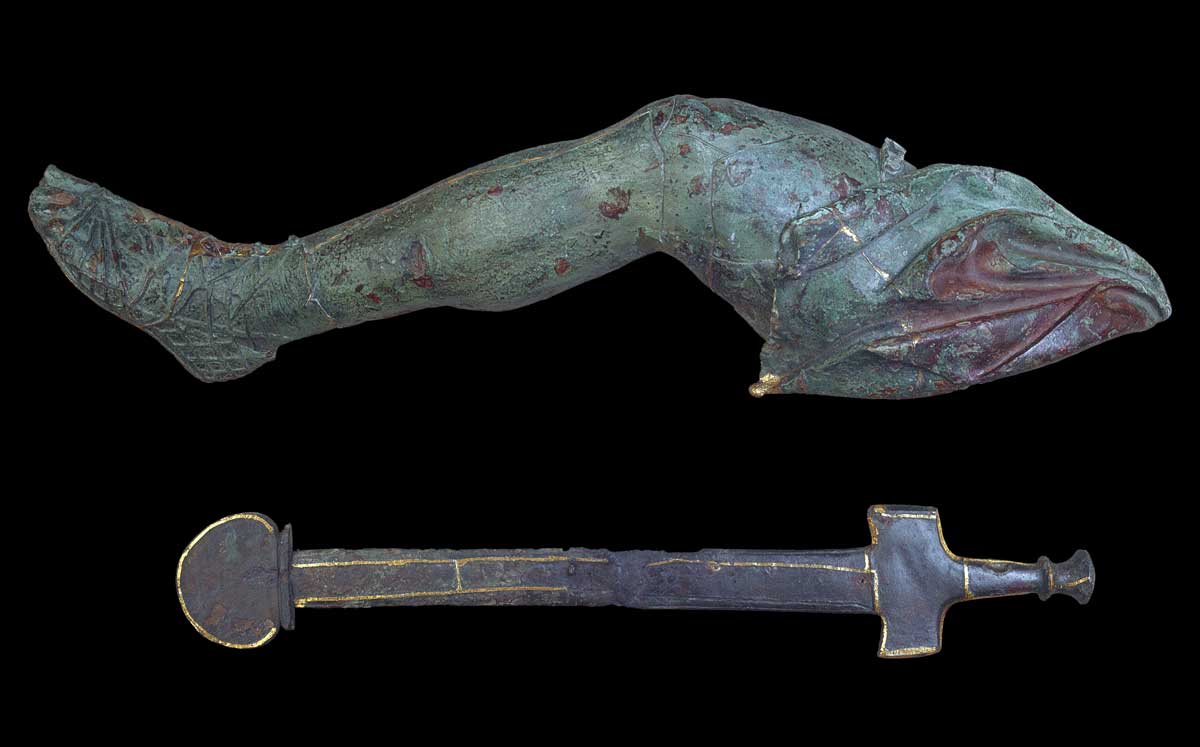Fallen Idols | History Today - 5 minutes read

In 1971, excavation of a well in the Athenian Agora produced two pieces of a large, bronze statue of a mounted warrior – a leg and a sheathed sword. Pottery found in the well dated their deposition to around 200 BC, the year of a dramatic episode of Athenian history. Engaged in a vicious war with Philip V of Macedon, the Athenians voted to destroy all the monuments to members of his dynasty. The statue fragments are thought to have belonged to a monument to an ancestor of Philip, a militaristic king known as Demetrius the Besieger. That the bronze was not melted down for reuse and even retains traces of expensive gold leaf evokes images of destruction by an emotional crowd, sparing no thought for salvaging the material. There are certainly parallels here with recent events. But the role of statues in ancient culture means that there are also important differences.
Statues were everywhere in ancient Greek cities. Sanctuaries and public spaces were filled with statues of gods, heroes, athletes, foreign kings, generals and local politicians. In this male-dominated culture most statues were of men. When the Greek world became part of the Roman Empire, statues of emperors took their place among the others. One Roman author claims that in his day there were 3,000 bronze statues in the cities of Rhodes and Athens, an astonishing figure considering that their populations numbered no more than a few tens of thousands. The number and variety of statues created a range of ways in which they were subtly given meaning: through their material – marble, bronze, gilded bronze or (exclusively for the gods) chryselephantine (gold and ivory) – through their size, their pose or costume, the height or shape of their pedestals and their location. Demetrius’ colossal equestrian monument, covered all over in gold, would have been particularly grand.
Demetrius was the son of one of Alexander the Great’s generals, Antigonus the One-Eyed. Athens fell under the influence of father and son during the so-called ‘Successor Wars’ at the turn of the third century BC, a turbulent conflict in which Alexander’s empire was carved up after his death. Demetrius rid Athens of a tyrant, confusingly also called Demetrius (of Phalerum), and in reward the Athenians bestowed unprecedented honours on him and his father. These included several statues, two of which – also gold, although not on horseback, so not the statue from the well – were set up in the centre of their agora next to the statues of the so-called Tyrannicides, credited, in popular tradition, with ushering in Athenian democracy. This prestigious location presented Demetrius and Antigonus as liberators of similar stature. The Athenians even instituted a festival in their name and worshipped them as ‘saviour gods’.
None of their statues were, strictly speaking, cult statues since they were not placed within a temple or sacrificed to, but they blurred the line between mortal and divine, as ancient statues often did.
An ancient story tells of a statue of a deceased athlete at Thasos that was routinely whipped by an enemy. The statue took its revenge by falling on the man and killing him. Venting anger on statues is, in part, satisfying because life-like images act as substitutes for the people they represent. That feeling must have been intensely charged in a culture where such images could be imbued with an animate presence and would sometimes fight back.
Statues in ancient cities were moved and dismantled for various reasons: as their subjects became forgotten; after they were plundered in war; to decorate the villas of wealthy Romans. Sometimes, though, they were destroyed for political reasons.
The Roman practice of damnatio memoriae – the expunging of statues, images and names of disgraced rulers and enemies of the state – is well known. When Demetrius of Phalerum was overthrown, all the statues of him in Athens – sources say there were 300 or more – were unceremoniously melted down to make chamber pots. Unlike in the current ‘statue wars’, however, the targets were invariably statues of political opponents still alive or recently dead. The toppling of the statues of Demetrius the Besieger and his father is perhaps the only example before the Christian iconoclasm of Late Antiquity of the violent destruction of statues set up generations previously.
Their statues stood for about as long as Colston’s at Bristol and Rhodes’ at Oxford, but they were destroyed not for what they symbolised but because they were ancestors of the hated enemy of the moment.
There were no ancient controversies in which old statues were found to be offensive to contemporary values, because the expectation that statues should represent the very best of humanity was alien to the Greeks and Romans. Statues were for the powerful and for those who performed services to their community, not for the righteous. If moral outrage had been a reason to tear down statues, Demetrius’ would not have lasted long: he once deeply offended the people of Athens by taking his new-found status as a god too literally and moving into one of the city’s most sacred buildings, the Parthenon.
One important way that the recent statue destructions do closely resemble those of antiquity, however, is that, despite accusations to the contrary, neither is an attempt to erase history. The Athenians made no real pretence to be erasing the memory of Philip or his family. Inscriptions with their names effaced were left standing, the gaps a powerful reminder of their disgrace. And the decree that ordered their monuments to be destroyed also stipulated that whenever public prayers were said for the wellbeing of the state, the king, his family, his army and the Macedonian people were to be cursed. With such prayers taking place daily there was little chance the kings would ever be forgotten.
Christopher Dickenson is Assistant Professor in the Centre for Urban Network Evolutions, Aarhus University.
Source: History Today Feed